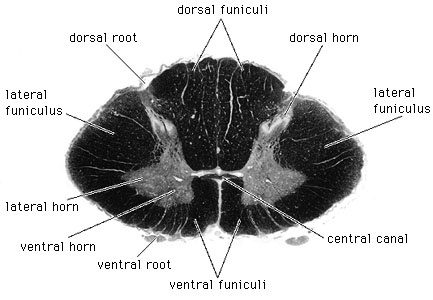spinal cord
anatomy
major nerve tract of vertebrates, extending from the base of the brain through the canal of the spinal column. It is composed of fibres that mediate reflex actions and that transmit impulses to and from the brain.
Like the brain, the spinal cord is covered by three connective-tissue envelopes called the meninges. The space between the outer and middle envelopes is filled with cerebrospinal fluid, a clear, colourless fluid that cushions the spinal cord.
 A cross section of the spinal cord reveals white matter arranged around a butterfly-shaped area of gray matter. The white matter consists of myelinated fibres, or axons (axon), that form nerve tracts ascending to and descending from the brain. The white matter is grouped into discrete sectors called funiculi. The gray matter contains cell bodies, unmyelinated motor-neuron fibres, and interneurons connecting the two sides of the cord. Gray-matter cells form projections called horns. Fibres exiting the spinal cord from the dorsal and ventral horns join in paired tracts to form the spinal nerves (spinal nerve). Information travels up the ascending tracts of neurons and is sorted by the brain. Responses are induced by nerve impulses traveling down the descending tracts that stimulate motor neurons or that initiate glandular secretion. (See also nervous system, human.)
A cross section of the spinal cord reveals white matter arranged around a butterfly-shaped area of gray matter. The white matter consists of myelinated fibres, or axons (axon), that form nerve tracts ascending to and descending from the brain. The white matter is grouped into discrete sectors called funiculi. The gray matter contains cell bodies, unmyelinated motor-neuron fibres, and interneurons connecting the two sides of the cord. Gray-matter cells form projections called horns. Fibres exiting the spinal cord from the dorsal and ventral horns join in paired tracts to form the spinal nerves (spinal nerve). Information travels up the ascending tracts of neurons and is sorted by the brain. Responses are induced by nerve impulses traveling down the descending tracts that stimulate motor neurons or that initiate glandular secretion. (See also nervous system, human.)- Baptist
- Baptiste
- baptistery
- Baptist Federation of Canada
- Baptist General Conference
- Baptist Missionary Association of America
- Baptist Union of Great Britain and Ireland
- Baptist World Alliance
- Baqqārah
- Bar
- Bara
- Bara Banki
- Barabbas
- Baraboo
- Barabás, Miklós
- Barack Obama
- Barack Obama: A More Perfect Union (2008)
- Barack Obama: Inaugural Address
- Barack Obama: Keynote Address at the 2004 Democratic National Convention
- Barack Obama: Victory Speech (2008)
- Baracoa
- Baradā River
- Baragwanathia
- Barahona
- Barahona de Soto, Luis